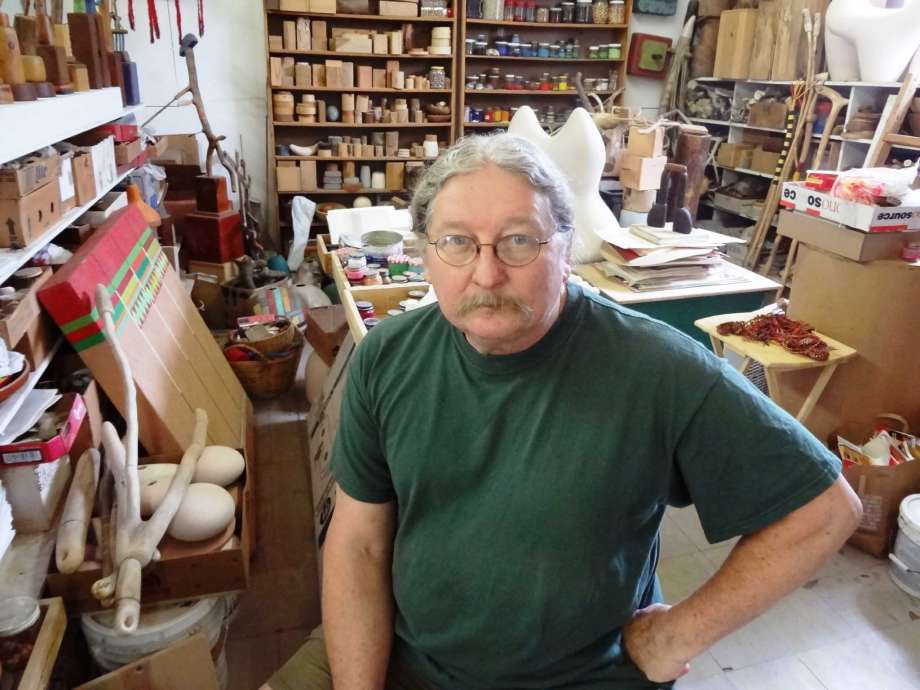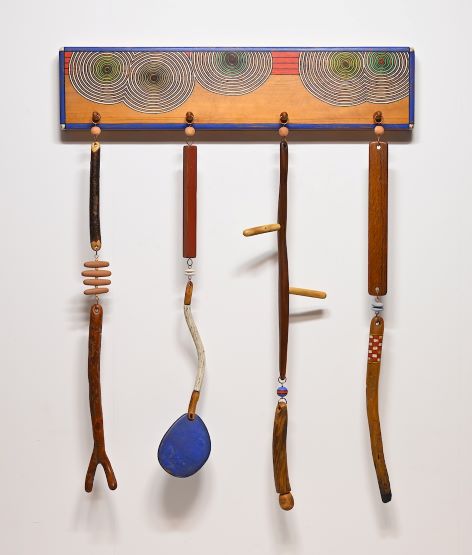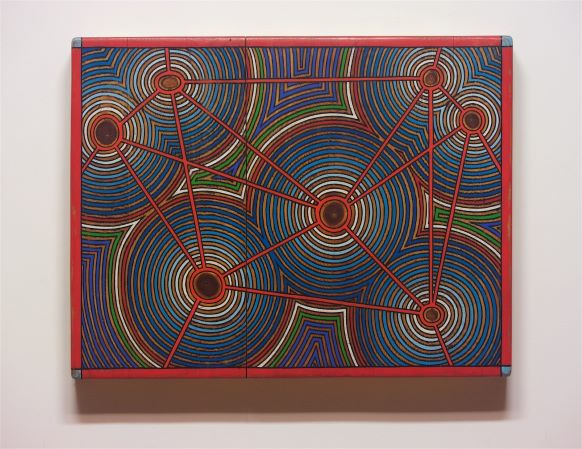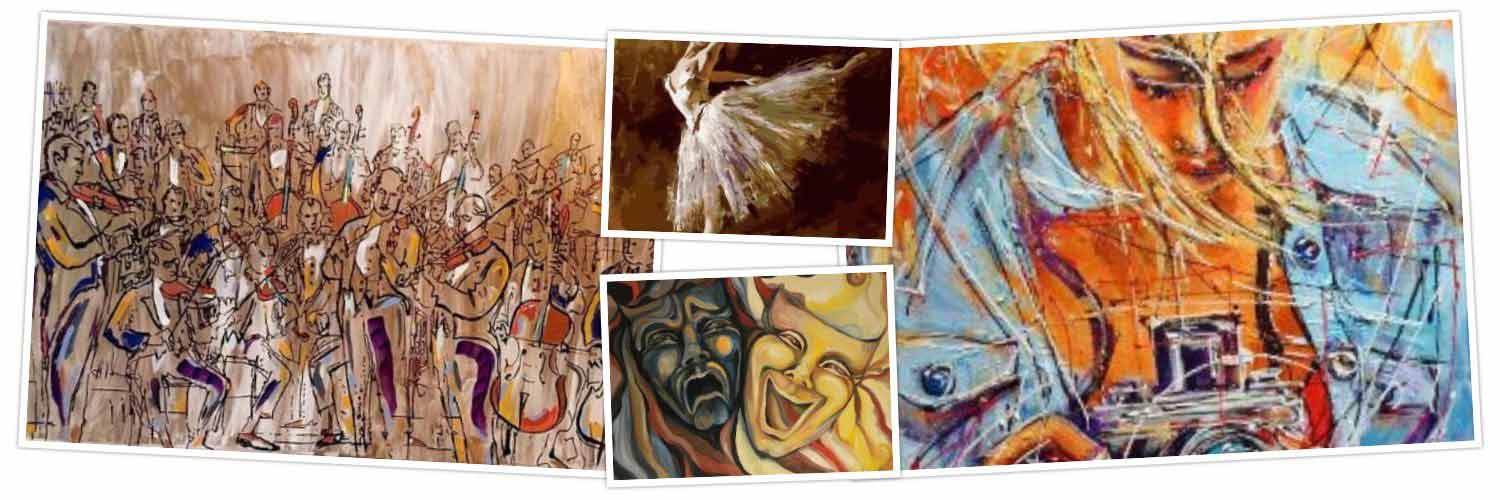Interview Express: Danville Chadbourne, Artist (In conjunction with a new exhibit at the Hunt Gallery)
By JASMINA WELLINGHOFF, Editor
Congratulations on the new show. Does it have a title?
No, we sort of debated about the title, but I decided I didn’t want to focus on anything that would be thematic. That’s because when I do that (choose a theme) it often leads people to places I don’t want them to go. So, I think the idea to show work that’s primarily two-dimensional (as opposed to his more sculptural creations) is enough of a premise. I want to let the work speak for itself. These are also all works in wood. And these pieces are very much about wood, about the material.

Your style is very distinct. When I see a piece like these here, I know it’s Danville Chadbourne. Talk a bit about how you developed it.
It’s a good question but the answer is that I didn’t develop it. It just evolved on its own, though it was a long organic evolution over a long haul. I’ve being doing this kind of work for 50 years. If you were to look at some pieces from the 70s, you would recognize my hand in them. I was always interested in organic image making and the suggestive possibilities of objects. Small shifts have taken place over time, but I just kept pursuing those impulsive ideas that seemed to reflect who I was and how I saw the world, in a poetic and kind of abstract way. As I continued to do that, certain forms and certain thematic things just kind of rose to the top and became dominant.
In the past few years, I’ve had four retrospective shows and it’s made me look at my old work in a different way, too. Forms, ideas, color relationships, -style, if you will – got more and more enriched through repetitiveness. I am really driven by the material nature of things. Look at these pieces here – I always start with a piece of wood and then improvise on what’s already there. So, it’s all about the boundary between accident the deliberate act.

How long does it take to get to the point when you feel a piece is finished?
I usually work on several pieces at the same time. It enhances my work. The pieces create a kind of cross-references. That enhances my process.
Can you recall a time when you saw an artwork that left a deep impression on you?
That’s a really difficult question for me to answer. I am interested in a lot of modernist artists like Picasso, Henry Moore and others, but in addition to that, the things that I got most excited about are non-Western things, like pre-Columbian art, African art, art from India… Those things still trigger the biggest responses from me. We (he and his wife Diana Roberts) were just in Fort Worth and saw this African art exhibition at the Kimbell, which is spectacular.
Were you also inspired by American Indian art from the Northwest? Some of your older sculptures resemble totem poles from that area.
Yes, I was really enthused by that stuff back in the 60s. But later, I also saw the anthropology museum in Mexico City, and I saw Tutankhamun, stuff that really moved me.
It’s not easy to make money with art, but you are successful at it.
I grew up in an environment without any art experiences,in Bryan, Texas. My parents were not interested in the arts. My grandmother, however, was influential in that regard. She was, what we would call today, a folk artist. She had strange things in her house. She and I got along well. She accepted what I did and I kind of liked what she did. So, in college I got a degree in art, and then I taught for 17 years in the academic system. I liked teaching but did not like that whole career path. All along, since I was an undergraduate, I had been showing my work.
I love exhibitions. They allow me to see my work in a formal setting that I can’t do in the studio where everything is piled up too closely. Here, in the gallery, I can see the pieces in this open space and it also allows me to have a dialogue with people about the artwork.

So, which pieces in this exhibit are the closest to your heart?
All of them are, but there are two recent pieces (he points them out: Dark Poems for the Ritual of Acquisition and Apprehensive Accumulation- Pieces of Time) that I call physical poetry. They consist of objects I collected during my travels and pieces that I invented. There’s meaning there but not representational meaning. These works have personal, private references for me. For instance, that stick on the far end of Dark Poems is a stick I used for barbecuing. Those sticks get to a place where I like the way they look, and I collect them. This other piece (Pieces of Time) is made entirely of oak wood. So, the piece reflects my interest in this particular wood. In a way, it’s about natural processes that shaped the wood.
Is there a piece, or more than one, that you don’t want to sell, don’t want to part with?
I am willing to part with them but Diana is not (laughs).
Who has had the most influence on your life?
I have to say, Diana. We have been together for over 30 years, and she’s the partner that I have always wanted to have. The important thing for me was that she, not only accepted what I did, but, more importantly, she’s interested in the things I am interested in. (His previous two wives were not) We can be in a museum for like eight hours and still be totally in sync with each other.
What was the happiest moment of your life?
I think it was the time with Diana when we first started living together. It was a fantastic, romantic time.
What was the worst time?
Probably some things from my marriage to my first wife. Relationships are always painful when they go off track.
What motivated you to travel to India and China?
All world cultures interest me. How people live, how they think, how they objectify their belief systems. Human beings have this compelling need to make images, especially when it comes to their religious beliefs. We went to India because I have been in love with Indian history and mythology. And I love Indian food. I’ve been cooking Indian food since the 70s. We went to temples and explored the shrines. I liked being in that cultural space. Also, I have always loved Indian colors.
Which San Antonio artists do you admire?
I have a lot of artist friends. My good friend (painter and photographer) John Mattson is one that I admire the most. I also admire Sylvia Benitez.
How has the pandemic affected you?
It gave me an incredible freedom of time. To me it was a blessing. I was free to do what I wanted to do.
Is any of your work in the collections of San Antonio museums?
Yes, I have a piece at the San Antonio Museum of Art and a couple of pieces at the McNay.
If you were the King of San Antonio with unrestricted power, what would you change/add/implement in our city?
Property taxes. I think it’s an evil situation right now with the appraisals and the taxes and people being run out of their homes. I think it’s disgusting.
——————————————————————————————————————–
Hunt Gallery, 4225 McCullough, 78212; free, 210-822-6527, www.HuntGallery.net

What a great interview with an iconic artist – thanks! Looking forward to the Hunt Gallery exhibit.